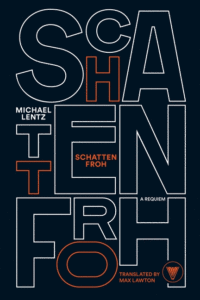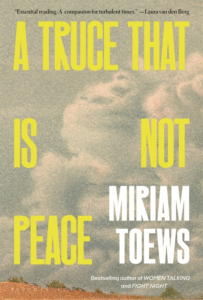Our goodie bag of great reviews this week includes Mark O’Connell on Alex Karp’s The Technological Republic, James Robins on Garrett M. Graff’s The Devil Reached Toward the Sky, Anahid Nersessian on Michael Lentz’s Schattenfroh, A.O. Scott on Dan Brown’s The Secret of Secrets, and Lorrie Moore on Miriam Toews’s A Truce That Is Not Peace.
Brought to you by Book Marks, Lit Hub’s home for book reviews.
*

“While all this was going on—while he was becoming America’s highest-paid CEO and facilitating a growing police state at home and a genocidal campaign in Gaza—Karp somehow managed to squeeze in writing a book. Or perhaps it would be more accurate to say that he managed to dictate one: The Technological Republic, which was published earlier this year, is credited to both Karp and one Nicholas W. Zamiska, Palantir’s head of corporate affairs and legal counsel to the office of the CEO. Speaking with Bari Weiss on her podcast, Karp put it as follows: ‘I would say, in complete candor, 95 percent plus of the ideas are mine, 90 percent of the writing is his. And the writing is phenomenal.’ The writing, I’m sorry to say, is not at all phenomenal; it is uniformly adequate. The division of literary labor, in any case, seems to be such that Karp deployed his own legal counsel in much the same manner as an ordinary person who didn’t want to put in the work might use a generative AI chatbot like ChatGPT, throwing out a mess of half-formed ideas to be put into serviceable prose.
…
“…as I made my way sluggishly through its pages—through its business-casual banalities, its pallid apologias for Western civilization and imperial violence—I found myself increasingly preoccupied by a single question: Why did Alexander Karp want to write this thing in the first place? I suspect that his reasons are at least partly related to the Silicon Valley cult of the tech-founder-as-philosopher-king, and have to do with Karp’s desire to be viewed as not just a businessman but also a public intellectual. This book exists, in other words, in order for Karp to have written a book.
…
“The book is filled with this sort of sanctimonious guff. If it were just another denunciation of cancel culture, it would be merely boring and belated. But coming from Alexander Karp, the CEO and cofounder of Palantir Technologies, this concern-trolling about a growing censoriousness in ‘the culture’ feels almost intentional in its absurdity. At times I approached the book, perhaps to preserve my own psychic integrity, as an avant-garde exercise in narrative unreliability, an experiment in the dizzying extremes of dramatic irony that I associate most with Charles Kinbote, the comically oblivious narrator of Nabokov’s Pale Fire. Again and again I found myself responding to some sententious lament about Silicon Valley’s lack of moral values by scrawling ‘You run Palantir!’ in the margin.
…
“If you want to know what a technological republic might look like, forget Alexander Karp’s insipid book; consider what is being constructed around you, and how little it resembles any kind of republic at all. Consider the bad times, and who they are good for.”
–Mark O’Connell on Alexander C. Karp’s The Technological Republic: Hard Power, Soft Belief, and the Future of the West (The New York Review of Books)

“The historian Garrett Graff tells us early on in his new book, The Devil Reached Toward the Sky: An Oral History of the Making and Unleashing of the Atomic Bomb, of the mountains he scaled to assemble this history of an atrocity. More than 100 books. Archives on several continents. A first draft of nearly 1.5 million words. Yet one important statement is missing from the pages that follow. It is a bold admission (and omission) that mutates the history of the Second World War:
‘There was never … any illusion on my part but that Russia was our enemy and that the project was conducted on that basis. I didn’t go along with the attitude of the country as a whole that Russia was a gallant ally. … Of course, that was so reported to the president.’
The italics are mine, but the speaker was Lt. Gen. Leslie Groves, overseer of the construction of the Pentagon and of the Manhattan Project. Consider how his statement complicates everything we’ve been told to believe about the obliteration of Hiroshima and Nagasaki 80 years ago. Could it be that the bomb wasn’t dropped on Japan just to save Americans the task of a brutal invasion but also to impress Joseph Stalin? Could it be that the coldly utilitarian logic of the bombing was warped by an additional motive: cementing the United States’ ultimate supremacy after the war?
The Devil Reached Toward the Sky is a handsome book. Graff tugs the reader from the earliest experiments in radiation to the young pilots who made an ashy hole of Nagasaki. His cast is various, their inclusion in a collection like this helped very much by their learning and erudition. Graff’s success is in marshaling, corralling. But this is an oral history, and oral history is a lush place to hide. By design, it forbids the historian’s best tools. Quotes can be placed in revealing position to one another, voices put in tension, but the historian is mostly invisible. Readers would normally expect an authority to make their own case about a subject, especially when the stakes are apocalyptic, but Graff crouches behind his sources—and his sources are incomplete.
…
“It’s important to shine a light on neglected histories. But there is a perversity in praising the scientific-industrial achievement of the project without a fuller reckoning with the ensuing shadowed age it helped to create.
…
“It is not only an academic question to judge the moral worth or strategic rationale of unleashing the strange alchemies of the atom. It is an urgent present-day question. Anyone making the case for Hiroshima and Nagasaki’s annihilation then is making the case for our annihilation now. If the trigger-pullers once thought using The Bomb was justified, they might think the same way again. Pay close attention to someone who insists Kazuo Chujo had to burn; be on your guard to anyone who claims a Japanese mother’s eyeballs had to melt to spare an American mother’s weeping. In its lapses, Graff’s book, perhaps unconsciously, helps this dangerous temptation persist—along with the myth that the bombings were inevitable or unavoidable. Better to have the argument now, before there’s no time left.”
–James Robins on Garrett M. Graff’s The Devil Reached Toward the Sky: An Oral History of the Making and Unleashing of the Atomic Bomb (The Washington Post)
“Only seventy-two pages into Schattenfroh, Michael Lentz’s bleak, confounding, and finally brilliant doorstopper of a novel, the story, which had just seemed to be getting off the ground, cuts short. The type gives way to facsimile pages covered with the handwritten names and ages of the more than 3,100 people who died in the Allied bombing of Düren, a town close to the western border of Germany. Part of an initiative code-named Operation Queen, the bombing lasted from 11:13 AM to 12:48 PM on November 16, 1944. Düren had a population of about 45,000. It was attacked, as Jörg Friedrich points out in his 2006 book The Fire: The Bombing of Germany, 1940–1945, with ‘4,600 high-explosive bombs and fifty thousand incendiaries,” meaning “at least one bomb was dropped for every person.’
…
“As you read through the list, you find yourself asking questions. Did Petronella Sartorius die with any of her four children in her arms? Did two-year-old Rolf Heinz Thal’s parents watch him burn to death or try to pry him out of the rubble? I have a newly immediate ability to imagine such scenarios after nearly two years of watching Israel’s bombardment of Gaza, about which it is impossible not to think when confronted with Lentz’s list of annihilated civilians—and those are the people who made it onto the list at all. ‘How many people,’ wonders Nobody, the pointedly anonymous narrator of Schattenfroh, ‘simply disintegrated at 1700 degrees Celsius and no longer even have a name?’
For reasons that remain obscure, it is Nobody’s job to transcribe Düren’s ‘book of the dead,; a registry with a separate section for ‘the “in-from-out-of-town”‘ who perished in the bombing. This detail, at once tragic and comic, painfully human and stupidly bureaucratic, captures something essential about Schattenfroh, an extremely dark novel about the horrors of modern European history laced with the delirious, disconcerting humor of a Hieronymus Bosch painting.
…
“It’s easy to praise Lentz’s ambition while sidelining his artistry. Schattenfroh is extremely long and prodigiously learned, with scenes—and even sentences—that veer from one century to another, and with a taste for literary and art historical in-jokes that might try the patience of even the most erudite reader. All the more impressive, then, is Max Lawton’s translation, which renders Lentz’s flinty though extravagant German into English sentences that are clear, nimble, and frankly full of beans, capturing the propulsive energy of the original text without sacrificing its difficulty.”
–Anahid Nersessian on Michael Lentz’s Schattenfroh (The New York Review of Books)

“You will find many astonishing sentences in The Secret of Secrets, Dan Brown’s latest TED-Talk travelogue thriller … including ones that start with a breathless adverb (‘impossibly,’ ‘remarkably,’ ‘conveniently’); ones that burst into excited italics; ones that are entirely in italics. Brown is above all an action writer, and his hero, Robert Langdon, is continually in hot pursuit of whoever is hotly pursuing him, whether in Florence, Rome, Barcelona or some other popular tourist destination. The nearly 700 pages of The Secret of Secrets zigzag across a hectic day, mostly in Prague, during which guns are fired, locks picked, hidden passageways discovered and shocking revelations delivered on the run. The hyperactive plotting runs on hyperventilating prose.
But a Dan Brown caper also runs on a certain kind of intellectual fuel. Since Langdon is, by profession, a professor (of symbology, at Harvard, in case you need reminding), his adventures are punctuated, or you might say padded, with brief lectures on a great many topics in history, science, philosophy and real estate. For a work of fiction, this novel is demonstratively proud of its facts…
…
“This time, unfortunately, the emphasis is less on the murk of the past—Masons or the Knights Templar, da Vinci or Dante, pagans or popes—than on a hazy future of awakened universal consciousness. Katherine’s inquiry into the nature of the mind is so consequential that powerful people are determined to destroy every physical and digital copy of her manuscript. But the more we learn about the content of her book, the more it all seems like hype. And as Brown’s book races toward its elaborate climax, his (and Langdon’s) breathless effusions about the neuro-technological progress that awaits us sound jarringly out of sync with the anxious, doomy present.
And yet I find myself unable to argue very strenuously against a book that believes so ardently in the importance of books—and, for that matter, in scientific research, academic prestige and luxury hotels. It may be best to read The Secret of Secrets as an artifact of a lost civilization, a misty evocation of vanished literary glory. It made me nostalgic for a golden age when a single written work could not only sell millions of copies, but also galvanize public opinion, spark furious debate and rotate history a few degrees on its axis. In other words, it made me nostalgic for The Da Vinci Code.”
–A.O. Scott on Dan Brown’s The Secret of Secrets (The New York Times)
“This one-sided sisterly correspondence is part of the book’s pondering and deciphering, its swirling arrangement, placed alongside fanciful but recurrent plans for a ‘Wind Museum,’ family anecdotes, and quotes from other writers, including Yiyun Li, who also lost two loved ones to suicide: ‘This tireless drive to write must have something to do with what cannot be told.’ Another, more recent quote from a short story by Li might also have been included in Toews’s book, since it seems coincidentally to describe the memoir’s structure: ‘A story was a kaleidoscope, and she would make allowances for chance variations, a silver bead falling into the center or a fleck of golden foil clinging to a corner.’
…
“This circling structure is what Miriam Toews has designed for her memoir, wheeling through death, family, and weather in an investigative manner. It may appear a formless form, but it has both elasticity and intent. She will not avoid anything. (In her 2018 novel Women Talking, her subject is a group of Mennonite women who have been routinely drugged and raped.) She tells us that on the Internet she has looked up photos of people hit by trains. She describes her dead sister’s stitched-up face.
She notes, too, that all her grandchildren carry magic wands: ‘We’ll be fine, they say. We have many magic wands.’ They also have toy lasers. ‘Have you been unable to stop yourself from crying, or really, well, let’s call it weeping, for no reason other than everything?’ this memoir asks. (Toews was once a flood inspector in Manitoba.) In her fantastical museum—for this memoir is the Wind Museum of her musings, her attempt to present the stormy atmosphere of the planet—moving air has been ingeniously captured and made into a kind of aural kaleidoscope of voices and sound. Hearing is, we are told, the last sense to vanish in death—thus sound is often the final, unsurrendered tool for reaching and saying. ‘The air…crackles, as it does when you speak of your beloved dead,’ Toews writes, quoting the novelist Lily King. A Truce That Is Not Peace is both an anguished commonplace book and an exhilarating brainstorm. Its winds whistle and wail.”
–Lorrie Moore on Miriam Toews’ A Truce That Is Not Peace (The New York Review of Books)



